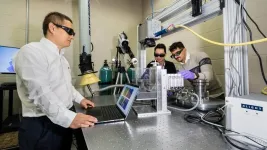(Press-News.org) While it’s well known that sleep enhances cognitive performance, the underlying neural mechanisms, particularly those related to nonrapid eye movement (NREM) sleep, remain largely unexplored. A new study by a team of researchers at Rice University and Houston Methodist’s Center for Neural Systems Restoration and Weill Cornell Medical College, coordinated by Rice’s Valentin Dragoi, has nonetheless uncovered a key mechanism by which sleep enhances neuronal and behavioral performance, potentially changing our fundamental understanding of how sleep boosts brainpower.
The research, published in Science, reveals how NREM sleep — the lighter sleep one experiences when taking a nap, for example — fosters brain synchronization and enhances information encoding, shedding new light on this sleep stage. The researchers replicated these effects through invasive stimulation, suggesting promising possibilities for future neuromodulation therapies in humans. The implications of this discovery potentially pave the way for innovative treatments for sleep disorders and even methods to enhance cognitive and behavioral performance.
The investigation involved an examination of the neural activity in multiple brain areas in macaques while the animals performed a visual discrimination task before and after a 30-minute period of NREM sleep. Using multielectrode arrays, the researchers recorded the activity of thousands of neurons across three brain areas: the primary and midlevel visual cortices and the dorsolateral prefrontal cortex, which are associated with visual processing and executive functions. To confirm that the macaques were in NREM sleep, researchers used polysomnography to monitor their brain and muscle activity alongside video analysis to ensure their eyes were closed and their bodies relaxed.
The findings demonstrated that sleep improved the animals’ performance in the visual task with enhanced accuracy in distinguishing rotated images. Importantly, this improvement was unique to those who actually fell asleep — the macaques that experienced quiet wakefulness without falling asleep did not show the same performance boost.
“During sleep, we observed an increase in low-frequency delta wave activity and synchronized firing among neurons across different cortical regions,” said first author Dr. Natasha Kharas, a former researcher in Dragoi’s lab and current resident in neurological surgery at Weill Cornell. “After sleep, however, neuronal activity became more desynchronized compared to before sleep, allowing neurons to fire more independently. This shift led to improved accuracy in information processing and performance in the visual tasks.”
The researchers also simulated the neural effects of sleep through low-frequency electrical stimulation of the visual cortex. They applied a 4-Hz stimulation to mimic the delta frequency observed during NREM sleep while the animals were awake. This artificial stimulation reproduced the desynchronization effect seen after sleep and similarly enhanced the animals’ task performance, suggesting that specific patterns of electrical stimulation could potentially be used to emulate the cognitive benefits of sleep.
“This finding is significant because it suggests that some of the restorative and performance-enhancing effects of sleep might be achieved without the need for actual sleep,” said Dragoi, study co-author, professor of electrical and computer engineering at Rice, the Rosemary and Daniel J. Harrison III Presidential Distinguished Chair in Neuroprosthetics at Houston Methodist and professor of neuroscience at Weill Cornell. “The ability to reproduce sleeplike neural desynchronization in an awake state opens new possibilities for enhancing cognitive and perceptual performance in situations where sleep is not feasible — such as for individuals with sleep disorders or in extenuating circumstances such as space exploration.”
The researchers further investigated their findings by building a large neural network model. They found that during sleep, both excitatory and inhibitory connections in the brain become weaker, but they do so asymmetrically, making inhibitory connections weaker than excitatory connections, which causes an increase in excitation.
“We have uncovered a surprising solution that the brain employs after sleep whereby neural populations participating in the task reduce their level of synchrony after sleep despite receiving synchronizing inputs during sleep itself,” Dragoi said.
The idea that NREM sleep effectively “boosts” the brain in this way, and that this resetting can be mimicked artificially, offers potential for developing therapeutic brain stimulation techniques to improve cognitive function and memory.
“Our study not only deepens our mechanistic understanding of sleep’s role in cognitive function but also breaks new ground by showing that specific patterns of brain stimulation could substitute for some benefits of sleep, pointing toward a future where we might boost brain function independently of sleep itself,” Dragoi said.
This research was supported by National Eye Institute grants 5R01EY026156 (V.D.) and 5F31EY029993 (N.K.).
END
New insights into sleep uncover key mechanisms related to cognitive function
Discovery suggests broad implications for giving brain a boost
2024-11-22
ELSE PRESS RELEASES FROM THIS DATE:
USC announces strategic collaboration with Autobahn Labs to accelerate drug discovery
2024-11-22
USC has embarked on a collaboration with Autobahn Labs, an accelerator for early-stage drug discovery, to identify and advance cutting-edge scientific findings into new therapies - with a special focus on critical unmet medical needs.
“Our collaboration with Autobahn Labs is a pivotal moment for our institution’s mission to bring academic innovations in drug discovery to market,” said Erin Overstreet, PhD, executive director of the USC Stevens Center for Innovation, which manages a broad portfolio of university-owned intellectual ...
Detroit health professionals urge the community to act and address the dangers of antimicrobial resistance
2024-11-22
DETROIT — Wayne State University's Center for Emerging and Infectious Diseases (CEID) is launching its participation in World AMR Awareness Week with an urgent message: the growing threat of antimicrobial resistance requires immediate community action, so it is critical to educate, advocate, and act now.
Antimicrobial Resistance (AMR) occurs when bacteria, viruses, fungi, and parasites no longer respond to antimicrobial agents. Because of drug resistance, antibiotics and other antimicrobial agents become ineffective and infections become difficult or impossible to treat, increasing the risk of spreading various diseases ...
3D-printing advance mitigates three defects simultaneously for failure-free metal parts
2024-11-22
University of Wisconsin–Madison engineers have found a way to simultaneously mitigate three types of defects in parts produced using a prominent additive manufacturing technique called laser powder bed fusion.
Led by Lianyi Chen, an associate professor of mechanical engineering at UW–Madison, the team discovered the mechanisms and identified the processing conditions that can lead to this significant reduction in defects. The researchers detailed their findings in a paper published on November 16, 2024, in the International Journal of Machine Tools and Manufacture.
“Previous research has normally focused on reducing one type of defect, but that would ...
Ancient hot water on Mars points to habitable past: Curtin study
2024-11-22
New Curtin University-led research has uncovered what may be the oldest direct evidence of ancient hot water activity on Mars, revealing the planet may have been habitable at some point in its past.
The study analysed a 4.45 billion-year-old zircon grain from the famous Martian meteorite NWA7034, also known as Black Beauty, and found geochemical ‘fingerprints’ of water-rich fluids.
Study co-author Dr Aaron Cavosie from Curtin’s School of Earth and Planetary Sciences said the discovery opened up new avenues for understanding ancient Martian hydrothermal systems associated ...
In Patagonia, more snow could protect glaciers from melt — but only if we curb greenhouse gas emissions soon
2024-11-22
In an era of dwindling glaciers, Southern Patagonia has managed to hold on to a surprising amount of its ice. But, A new study in Scientific Reports from INSTAAR postdoc Matthias Troch suggests that this protective effect might be pushed up against its limits soon.
Before making predictions, Troch and his collaborators looked back in time. They used an equation that, when plugged into NASA’s ice-sheet and sea-level system model, simulated glacial dynamics for the past six millenia. The results showed that precipitation, not temperature, was the main culprit of glacier fluctuation during around 4,500, of the past 6,000 years, or 76 percent of the time. In ...
Simplicity is key to understanding and achieving goals
2024-11-22
People’s preference for simple explanations of any situation is connected to their desire to execute tasks efficiently, finds a new study from the University of Waterloo.
"These findings show that our preference for simpler explanations mirrors how we evaluate actions. Simplicity isn't just valued in explanations—it's part of how we think about achieving results efficiently," said Claudia Sehl, lead author and a PhD candidate in developmental psychology at Waterloo.
Sehl collaborated with Waterloo developmental psychology professors Ori Friedman and Stephanie Denison on this study. They conducted seven experiments involving 2,820 ...
Caste differentiation in ants
2024-11-22
Most ants have two morphologically differentiated adult castes - queens and workers - each irreversibly specialized for either reproduction or nonreproductive altruism such as foraging, defense and care of maternal brood. Adult gynes (virgin queens) normally have higher body mass, wings and frontal eyes, as well as enlarged ovaries and a sperm storage organ. In contrast, workers are wingless females with smaller body size and degenerated reproductive tracts, usually without a sperm storage organ. In 1910, the American entomologist ...
Nutrition that aligns with guidelines during pregnancy may be associated with better infant growth outcomes, NIH study finds
2024-11-22
Expectant mothers who maintain a diet that meets USDA dietary guidelines during pregnancy may be more likely to have infants with healthy birthweights, steadier growth patterns, and potentially a reduced risk of obesity later in childhood, according to a new study funded by the Environmental influences on Child Health Outcomes (ECHO) Program at the National Institutes of Health.
The research, involving more than 2,800 mother-child pairs across eight ECHO Cohort Study Sites, suggests that following a healthy ...
New technology points to unexpected uses for snoRNA
2024-11-22
Dynamic, reversible modifications of DNA and RNA regulate how genes are expressed and transcribed, which can influence cellular processes, disease development, and overall organismal health. Small nucleolar RNAs (snoRNAs) are a common but overlooked group of guide RNA molecules that steer chemical modifications to cellular ribosomal RNA (rRNA) targets, like an usher showing someone to their seat in a theater.
Researchers from the University of Chicago recently developed a new approach for identifying new cellular RNA targets of snoRNAs. ...
Racial and ethnic variation in survival in early-onset colorectal cancer
2024-11-22
About The Study: In this cohort study, racial and ethnic disparities in early-onset (before 50 years of age) colorectal cancer mortality were evident, with the highest burden among Native Hawaiian or Other Pacific Islander and non-Hispanic Black individuals. These results provide evidence of the role of social determinants of health in explaining these differences.
Corresponding Author: To contact the corresponding author, Maria Elena Martinez, PhD, email e8martinez@health.ucsd.edu.
To access the embargoed study: Visit our For The Media website at this link https://media.jamanetwork.com/
(doi:10.1001/jamanetworkopen.2024.46820)
Editor’s Note: Please ...
LAST 30 PRESS RELEASES:
SwRI upgrades nuclear magnetic resonance laboratory for pharmaceutical R&D
House sparrows in northern Norway can help us save other endangered animals
Crohn's & Colitis Foundation survey reveals more than 1/3 of young adults with IBD face step therapy insurance barriers
Tethered UAV autonomous knotting on environmental structures for transport
Decentralized social media platforms unlock authentic consumer feedback
American Pediatric Society announces Vanderbilt University School of Medicine as host institution for APS Howland Visiting Professor Program
Scientists discover first method to safely back up quantum information
A role for orange pigments in birds and human redheads
Pathways to net-zero greenhouse gas emissions for Southeast Asia
A JBNU–KIMS collaborative study on a cost-effective alloy matches superalloys for power plants and energy infrastructure
New study overturns long-held model of how plants coordinate immune responses.
New AI model predicts disease risk while you sleep
Scientists discover molecular ‘reshuffle’ and crack an 80-year-old conundrum
How stressors during pregnancy impact the developing fetal brain
Electrons lag behind the nucleus
From fungi to brain cells: one scientist's winding path reveals how epigenomics shapes neural destiny
Schizophrenia and osteoporosis share 195 genetic loci, highlighting unexpected biological bridges between brain and bone
Schizophrenia-linked genetic variant renders key brain receptor completely unresponsive to both natural and therapeutic compounds
Innovative review reveals overlooked complexity in cellular energy sensor's dual roles in Alzheimer's disease
Autism research reframed: Why heterogeneity is the data, not the noise
Brazil's genetic treasure trove: supercentenarians reveal secrets of extreme human longevity
The (metabolic) cost of life
CFRI special issue call for papers: New Frontiers in Sustainable Finance
HKU Engineering scholar demonstrates the smallest all-printed infrared photodetectors to date
Precision empowerment for brain "eavesdropping": CAS team develops triple-electrode integrated functional electrode for simultaneous monitoring of neural signals and chemical transmitters during sleep
Single-capillary endothelial dysfunction resolved by optoacoustic mesoscopy
HKU three research projects named among ‘Top 10 Innovation & Technology News in Hong Kong 2025’ showcasing excellence in research and technology transfer
NLRSeek: A reannotation-based pipeline for mining missing NLR genes in sequenced genomes
A strand and whole genome duplication–aware collinear gene identification tool
Light storage in light cages: A revolutionary approach to on-chip quantum memories
[Press-News.org] New insights into sleep uncover key mechanisms related to cognitive functionDiscovery suggests broad implications for giving brain a boost




